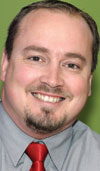

Beckhoff Automation was established in 1980 and the first PC-based machine controller was delivered by just six years later. It was a ‘simple’ controller for a double mitre saw, which encompassed single-axis positioning control with a few machine sequence functions. The saw was a well-known standard machine, which became a direct sales success for the manufacturer due to the innovative PC control technology. The combination of IT functions and automation technology in a controller was and is still a revolution. The benefits resulting from this revolution were recognised even at the beginning and received enthusiastically by machine manufacturers and end users. For example, data could be read directly into the machine controller using standard IT media (floppy disks). In 1986, this represented significant progress in productivity.
Beckhoff expanded the company’s PC control concept consistently and quickly in the years that followed: multi-axis NC functions and a complete, integrated software PLC enabled the PC-based control of highly complex machines and plants. It should be mentioned here that Beckhoff has advanced this technology in close cooperation with many mid-sized customers, who were open to the new technology concepts and certainly benefited from them. These ambitious companies have made an important historical contribution to the development of PC control.
In 1990, PC control technology had matured to the extent that Beckhoff presented the concept to the wider public for the first time at Hanover Fair. The professional world was surprised, sceptical and impressed. The high performance and value for a low cost quickly convinced many customers, however. Starting at this Hanover Fair, PC control has become generally accepted worldwide as a standard technology in automation and has enabled the Beckhoff workforce to grow from 40 employees at that time to 1650 people worldwide today.
There have been no fundamental changes to this successful concept since then: the abstraction of the control function from the device hardware and the consistent use of ‘mainstream’ IT technologies converging with the principles of automation technology lead, on the one hand, to continuously improving performance and functionality and, on the other, to cost reductions. The PC Control principle is very simple: a powerful industrial PC, an equally high-performance fieldbus to which peripheral devices for sensor and actuator systems are connected and control software with real-time capability for motion and logic – nothing more is required.
Of course, Beckhoff has developed further important products over the last 25 years that could be considered milestones, since they each represent a smaller or larger revolution and have contributed in no small way to the current state of PC-based automation. I would like to mention here:
* 1989: Lightbus – fibre optic fieldbus for fast I/O coupling.
* 1995: Bus Terminals – fine granular I/Os.
* 1996: TwinCAT – standard real-time automation software running on Windows.
* 2003: EtherCAT – real-time Ethernet for automation.
* 2005: TwinSAFE – functional safety in non-safe environments.
* 2006: Scientific Automation – measuring technology and engineering science as a control component.
* 2008: XFC – eXtreme Fast Control for efficient machines and plants.
* 2010: TwinCAT 3 – engineering tool for object-oriented and modular automation.
* 2011: CCAT – C for Control Automation Technology – automation based on high-level languages.
When we at Beckhoff want to describe the variety of demands placed on automation, we say: “The world is big and colourful”. And we are proud of the fact that our PC control technology has found the widest use in this big, colourful and also beautiful world: in machine construction and plant engineering, in measurement and testing technology, in wind turbines and photovoltaic manufacturing, in office buildings and private houses, in stage technology and on luxury yachts, in medical technology and in particle accelerators. PC Control from Beckhoff is the basis for intelligent, powerful and reliable control technology in all fields.
As we have proven in the last 25 years, our focus is on innovation and quality, and we look forward to sharing our next 25 years of New Automation Technology with you.
For more information contact Kenneth McPherson, Beckhoff Automation, +27 (0)11 795 2898, [email protected] , www.beckhoff.co.za
| Tel: | +27 11 795 2898 |
| Email: | [email protected] |
| www: | www.beckhoff.com |
| Articles: | More information and articles about Beckhoff Automation |

© Technews Publishing (Pty) Ltd | All Rights Reserved